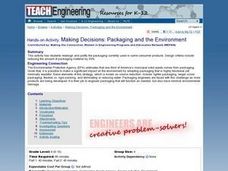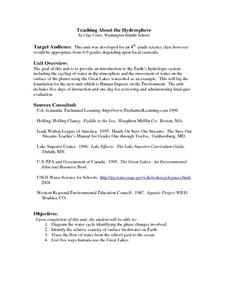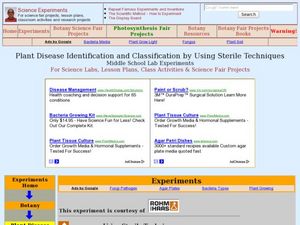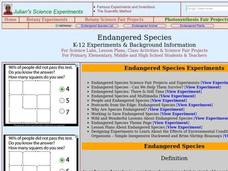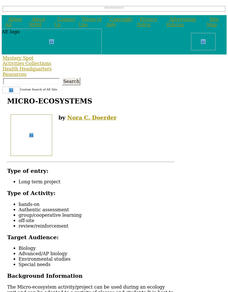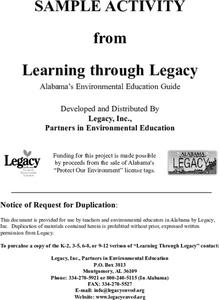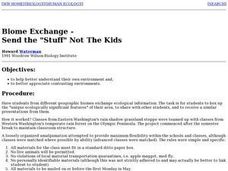Curated OER
What's the Connection?
Students explain hardground communities in the Gulf of Mexico. In this deep-sea ecosystem lesson, students investigate the connection between deep-sea ecosystems and petroleum deposits. They discuss the relationship between hydrocarbon...
Curated OER
Making Decisions: Packaging and the Environment
Students work in small groups to redesign the packaging of several common items. They attempt to reach the goal of 25% reduction in packaging materials currently used and explore the impact of various materials and designs in landfills...
Curated OER
Teaching About the Hydrosphere
Eighth graders are introduced to the Earth's hydrologic system including the cycling of water in the atmosphere and the movement of water on the surface of the planet using the Great Lakes watershed as an example.
Curated OER
TE Activity: Hot or Not
Students examine how the human immune system responds to germs and explain what a fever is. They design a thermometer in order to further explore temperature before completing a temperature conversion worksheet. They detail the work of...
Curated OER
Climate And the Greenhouse Effect
Students demonstrate the greenhouse effect. They recognize that relatively small changes to our environment can stimulate significant climate changes. They determine that the "scientific method" is a process of testing hypotheses and...
Curated OER
Plant Disease Identification and Classification by Using Sterile Techniques
Seventh graders identify how to use sterile techniques when identifying plant pathogens. In this plant diseases lesson students complete a lab activity in which they see how plant diseases are identified and classified.
Curated OER
Hide In Plain Sight
Students view video clips and use the Internet to look for hidden animals. They then use the Internet to print out animal shapes and color them. They create environments on construction paper in which their animals can hide.
Curated OER
Energy Sources
Learners identify natural resources and describe the difference between renewable and non-renewable resources. They also identify the disadvantages and advantages of the resources.
Curated OER
A Recipe for Air
Learners create a pie graph using M&Ms to demonstrate the composition of air. They label each section of the graph, and list the fractions from largest to smallest.
Curated OER
Dangerous Air
Students investigate how pollution is a global issue. They locate the countries affected by radiation from Chernobyl, sequence the progress of radiation transport from Chernobyl and plot the pollution points on a world map, and read and...
Curated OER
Insect Monitoring
Students practice the scientific method in the classroom, either in preparation or as a substitution for real-world field experience. They examine a simulated biodiversity research situation, using a "mini-plot" or
sampling square...
Curated OER
Endangered Species
Students create a postcard about endangered species. In this biology lesson, students identify how human activities endanger other species. They research and recommend ways to help protect them.
Curated OER
Biodiesel: An Alternative Fuel Source
Students explore the advances that are being made in alternative fuels.In this biodiesel lesson students evaluate different petroleum and alternative fuels.
Curated OER
Pollution Prevention At Ft. Riley
Student examine methods of pollution reduction used at Ft. Riley military institution. Students review the economic impact of the use of enviromentally sensitive materials.
Curated OER
Micro-Ecosystems
Students create a sustainable, self-contained ecosystem in a ten-gallon aquarium.
Curated OER
Garbage Pizza
Students examine amount of garbage disposed of by average household weekly, classify different categories of garbage and describe composition of landfills, investigate what happens to waste after it is collected by garbage trucks, and...
Curated OER
THE BUSINESS OF CLEAN AIR
Learners determine that air pollution control is caused by a combination of market incentives and government regulation. They realize that businesses exist to make profits for their owners and that governments make rules for individuals...
Curated OER
Biodegradability
Students study the effects of water, salt water and heat on common household materials. They separate an emulsion and show that the materials are completely recoverable and observe the effect of acetone and water on polystyrene.
Curated OER
Oil Spill!
Young scholars examine how oil spills are cleaned through an interactive program. They review the facts of oil spills and how the oil spreads. They discuss the short and long term effects of a spill and how they can be avoided.
Curated OER
Energy of the Future
Learners examine technologies that already exist and record their findings in a journal. They work with students in other countries to explore alternative energy sources They publish their designs online.
Curated OER
Biome Exchange - Send the "Stuff" Not The Kids
Students exchange ecological information with students from different geographic biomes. They box up the "unique ecologically significant features" of their area, send the box to another class in another area and then receive a similar...
Curated OER
Plant Needs
Students explore the needs of plants. In this plants biology lesson, students work in groups to perform an experiment with tomato plants. Each group records observations in a journal, takes pictures, and interprets the results of...
Curated OER
Watershed Tourist
Students recognize and categorize different bodies of water. In this watershed and water environments lesson, students "Follow the Water from Brook to Ocean." Students define the different bodies of water and sort from smallest to...
Curated OER
Tropism
Students conduct various experiments on tropism. In this biology instructional activity, students explain how gravity affects the growth of plant roots. They identify the different types of tropisms.



